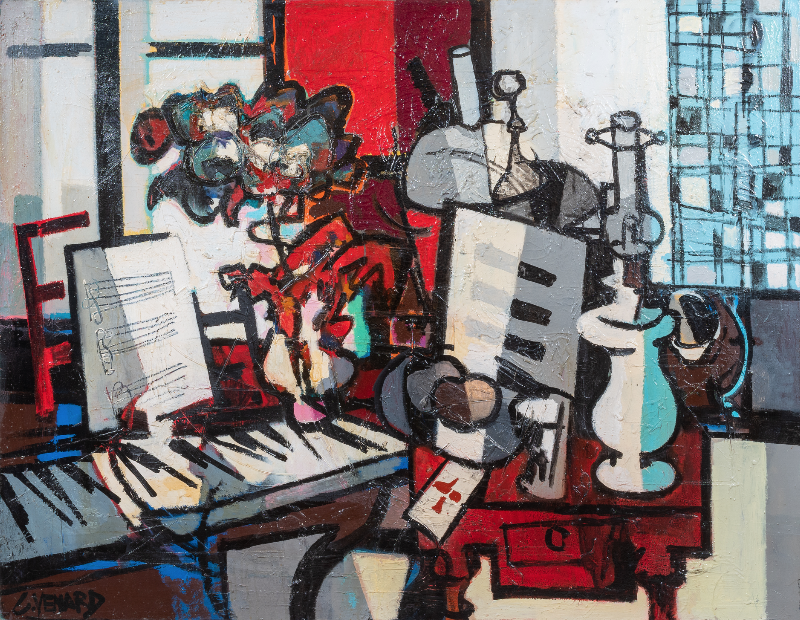Signed
Size (inches) : 45 (h) x 58 (w)
Size (cm) : 114.3 (h) x 147.32 (w)
View on background colour: Dark Graphite
string(6) "string"
string(1768) "
'Nature Morte au Piano' rings true to Venard's style of bold colours and heavily applied impasto. His post-cubist style is emphasised by the chaotic composition that takes your eyes all over the canvas, almost struggling to rest. In addition to the objects squeezed onto the desk, the extreme blocks of red juxtaposed against the stark white and black outlines makes the painting very energetic to look at.
Claude Venard was born in 1913 into a business family from Burgogne. At the age of 17 he began to take evening classes in painting at the Ecole des Arts Appliques. However, after six years of conscientious study, he was forced, in order to support himself, to spend most of 1936 working as a restorer at the Louvre Museum. This experience, however, turned out to be beneficial in as much as it enabled the young artist to fill the gaps still existing in his artistic education.Upon Venards release from the army, at the end of World War II, his life was transformed. With recognition came the chance to put painting before all else. In 1945, through his continued friendship with Gruber and Marchand, Venard shared mutual success. He remained faithful to a post-Cubist compositional style, and progressively accentuated the chromatism of his pallet up to reaching the crudest of colours, which he used in very thick forms and sometime applied with a pallet knife. Venards career was a happy one, punctuated by one man shows in Paris, London, New York, Philadelphia, Chicago, Dusseldorf, Munich, Buenos Aires, Tokyo, Canada, Belgium and Holland. The artist loved life in all its aspects and one is inclined to feel that he may have been in search of a genre of painting that would respond to even the most earthy appetites.
"
'Nature Morte au Piano' rings true to Venard's style of bold colours and heavily applied impasto. His post-cubist style is emphasised by the chaotic composition that takes your eyes all over the canvas, almost struggling to rest. In addition to the objects squeezed onto the desk, the extreme blocks of red juxtaposed against the stark white and black outlines makes the painting very energetic to look at.
Claude Venard was born in 1913 into a business family from Burgogne. At the age of 17 he began to take evening classes in painting at the Ecole des Arts Appliques. However, after six years of conscientious study, he was forced, in order to support himself, to spend most of 1936 working as a restorer at the Louvre Museum. This experience, however, turned out to be beneficial in as much as it enabled the young artist to fill the gaps still existing in his artistic education.Upon Venards release from the army, at the end of World War II, his life was transformed. With recognition came the chance to put painting before all else. In 1945, through his continued friendship with Gruber and Marchand, Venard shared mutual success. He remained faithful to a post-Cubist compositional style, and progressively accentuated the chromatism of his pallet up to reaching the crudest of colours, which he used in very thick forms and sometime applied with a pallet knife. Venards career was a happy one, punctuated by one man shows in Paris, London, New York, Philadelphia, Chicago, Dusseldorf, Munich, Buenos Aires, Tokyo, Canada, Belgium and Holland. The artist loved life in all its aspects and one is inclined to feel that he may have been in search of a genre of painting that would respond to even the most earthy appetites.










